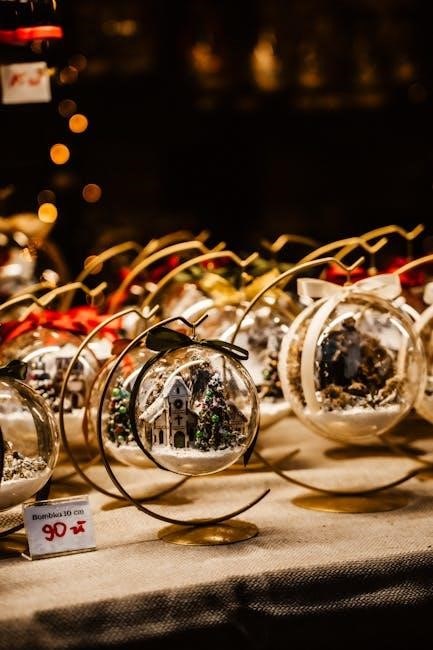Hazel Atlas Glass is a cherished collector’s item‚ renowned for its historical significance and distinctive designs. Understanding its markings and patterns is crucial for collectors to determine value and authenticity.
History of the Hazel-Atlas Company
The Hazel-Atlas Company was established in 1902 in Washington‚ Pennsylvania‚ through the merger of the Hazel Glass Company and the Atlas Glass and Metal Products Company. Known for producing high-quality glassware‚ Hazel Atlas became a prominent name in the industry‚ manufacturing items such as jars‚ bottles‚ and household glass products. The company gained fame for its functional and aesthetically pleasing designs‚ which appealed to both everyday users and collectors. During the Great Depression‚ Hazel Atlas innovated by introducing colorful‚ whimsical patterns‚ including the famous “Big Top Peanut Butter” glassware. This strategy helped the company remain competitive despite economic challenges. Hazel Atlas continued operations until the mid-20th century‚ leaving a lasting legacy in the world of glassware collectibles.

Significance of Hazel Atlas Glass in Collecting Communities

Hazel Atlas Glass holds a special place in collecting communities due to its unique designs‚ historical value‚ and nostalgic appeal. Many collectors seek these pieces for their vibrant colors‚ intricate patterns‚ and the stories they tell about mid-20th-century American life. The glassware’s durability and craftsmanship have ensured its longevity‚ making it a prized possession for enthusiasts. Additionally‚ Hazel Atlas items are highly sought after for their rarity‚ as certain patterns and pieces were produced in limited quantities; The availability of comprehensive guides‚ such as the Hazel-Atlas Glass Identification and Value Guide by Gene and Cathy Florence‚ has further fueled interest‚ providing collectors with the tools to identify and appraise their finds. This has created a thriving community of collectors who value both the aesthetic and historical significance of Hazel Atlas Glass.
Identifying Hazel Atlas Glass
Hazel Atlas Glass can often be identified by its mold numbers and factory codes found on the base of pieces‚ aiding collectors in verifying authenticity and age.
Common Markings and Signatures
Hazel Atlas Glass pieces often feature distinctive markings‚ such as mold numbers and factory codes‚ which are essential for identification. These markings are typically found on the base of items and may include letters like “HA” or “H over A.” Mold numbers‚ often single or double digits‚ help identify specific molds used in production. Additionally‚ some pieces may bear pattern names or logos‚ aiding in verification. The presence of these markings not only confirms authenticity but also provides insights into the production date and factory location. Collectors rely on these signatures to distinguish Hazel Atlas Glass from other manufacturers. The Hazel-Atlas Glass Identification and Value Guide by Gene and Cathy Florence offers detailed images and descriptions of these markings‚ making it an invaluable resource for enthusiasts seeking to authenticate and value their collections.
Understanding Mold Numbers and Factory Codes
Mold numbers and factory codes are crucial elements in identifying Hazel Atlas Glass pieces. Mold numbers‚ often single or double digits‚ are embossed on the base and represent the specific mold used during production. These numbers help collectors trace the origins and age of an item. Factory codes‚ such as letters like “HA” or “H over A‚” indicate the manufacturing location. These markings provide valuable insights into the production process and help distinguish genuine Hazel Atlas pieces from reproductions. The Hazel-Atlas Glass Identification and Value Guide by Gene and Cathy Florence includes detailed charts and explanations of these codes‚ enabling collectors to decode and interpret them accurately. Understanding these codes is essential for authenticating and valuing Hazel Atlas Glass effectively.
Popular Hazel Atlas Glass Patterns
Hazel Atlas Glass patterns are beloved for their timeless designs and historical charm. Produced by the Hazel-Atlas Company‚ these pieces were popular in mid-century households. Their diverse designs‚ ranging from elegant to whimsical‚ have made them highly sought after by collectors today.
Iconic Designs and Their Characteristics
Hazel Atlas Glass is celebrated for its iconic designs‚ which blend functionality with artistic flair. One of the most recognizable patterns is the Big Top Peanut Butter design‚ featuring colorful circus motifs that captivate collectors. Another standout is the Gothic pattern‚ known for its intricate‚ lace-like details and timeless elegance. These designs often incorporate vibrant colors and unique shapes‚ making them highly distinguishable. The Swirl and Geometric patterns are also prized for their modernist aesthetics. Each design reflects the company’s commitment to quality and craftsmanship. Collectors often seek pieces with original markings and minimal wear‚ as these retain higher value. The variety of designs ensures there’s something for every collector‚ from whimsical to sophisticated styles.
Rare and Highly Sought-After Patterns
Rare Hazel Atlas Glass patterns are highly coveted by collectors due to their uniqueness and limited production. The Cloverleaf and Starlight patterns are particularly scarce‚ with intricate designs that set them apart. The Parchment pattern‚ featuring a textured‚ embossed design‚ is also highly sought after and rarely found in pristine condition. Collectors often pursue these patterns for their historical significance and aesthetic appeal. Limited quantities and exceptional craftsmanship make these pieces standout treasures. Their rarity not only enhances their value but also makes them a hallmark of a distinguished collection. For serious collectors‚ these patterns are a true gem‚ embodying the artistry and legacy of Hazel Atlas Glass.

Determining the Value of Hazel Atlas Glass

Value determination involves assessing condition‚ rarity‚ demand‚ and historical significance. Factors like mold numbers‚ factory codes‚ and pattern popularity guide accurate appraisals and pricing.

Factors Influencing Value
The value of Hazel Atlas Glass is influenced by several key factors. Condition plays a significant role‚ with pieces in pristine shape commanding higher prices. Rarity is another critical factor‚ as limited production runs or discontinued patterns can elevate value. Demand also fluctuates‚ with certain designs or historical significance driving collector interest. Historical context‚ such as ties to specific events or eras‚ can enhance desirability. Additionally‚ mold numbers and factory codes provide authenticity and provenance‚ impacting appraisals. Market trends and collector preferences further shape value‚ as do the presence of original packaging or documentation. Understanding these elements is essential for accurate valuations and informed buying or selling decisions.
How to Research and Appraise Your Pieces
To accurately research and appraise Hazel Atlas Glass‚ start by consulting trusted resources like the Hazel-Atlas Glass Identification and Value Guide by Gene and Cathy Florence. Examine your piece for mold numbers‚ factory codes‚ and distinctive patterns‚ as these details are critical for identification. Compare your findings with reference images and descriptions in guides or online databases. Check marketplace listings on platforms like eBay or Etsy to see similar items and their sale prices. Join collector communities or forums for insights and expert opinions. Lastly‚ consider hiring a professional appraiser for high-value or rare items to ensure an accurate assessment. Proper documentation and provenance can significantly enhance your piece’s appraisal value.

Resources for Collectors

Collectors can rely on The Hazel-Atlas Glass Identification and Value Guide by Gene and Cathy Florence for detailed insights and valuations. Online marketplaces and collector forums also offer valuable resources for buying‚ selling‚ and researching Hazel Atlas Glass pieces.
The Hazel-Atlas Glass Identification and Value Guide by Gene and Cathy Florence
The Hazel-Atlas Glass Identification and Value Guide by Gene and Cathy Florence is a comprehensive resource for collectors. Published in 2009‚ this large‚ hardcover book is organized by categories such as children’s dishes‚ tumblers‚ and food containers‚ making it easy to navigate. It features hundreds of color photographs‚ providing clarity for identification. The guide offers detailed valuations and descriptions of various Hazel Atlas Glass pieces‚ helping collectors determine authenticity and value. Its user-friendly format ensures that even novice collectors can benefit. With updated information and extensive coverage‚ this guide is a must-have for anyone serious about Hazel Atlas Glass collecting. It remains a trusted reference in the collector community‚ offering insights and expertise at your fingertips;
Online Communities and Marketplaces for Buyers and Sellers
Online platforms have become essential for Hazel Atlas Glass enthusiasts to connect‚ trade‚ and learn. Websites like eBay and Etsy offer extensive listings of Hazel Atlas Glass pieces‚ with detailed photos and descriptions. Social media groups and forums dedicated to vintage glassware provide spaces for collectors to share knowledge and showcase their finds. Facebook Marketplace and specialized collector communities are also valuable for buying‚ selling‚ and networking. These platforms often feature rare patterns and hard-to-find items‚ making them indispensable for serious collectors. Additionally‚ online marketplaces allow for easy comparison of prices and conditions‚ helping buyers make informed decisions. Engaging with these communities can enhance your collecting journey and provide access to a wealth of expertise and resources.
Hazel Atlas Glass remains a cherished collectible‚ with its rich history and unique designs captivating enthusiasts. The Florence guide is indispensable for identifying and valuing pieces‚ ensuring the hobby’s vibrant future.

Final Tips for Collectors
Hazel Atlas Glass collecting is a rewarding hobby‚ but it requires diligence and knowledge. Always consult trusted resources like Gene and Cathy Florence’s guide for accurate identification and valuation. When examining a piece‚ look for mold numbers and factory codes‚ as these are critical for authenticity. Condition plays a significant role in value‚ so inspect items for chips‚ cracks‚ or wear. Researching similar pieces online and in collector communities can provide insights into market trends. Joining collector forums or clubs can also connect you with experts and enthusiasts. Lastly‚ be patient and thorough when appraising or purchasing pieces‚ as rare patterns can be elusive. By staying informed and meticulous‚ collectors can build a meaningful and valuable collection of Hazel Atlas Glass.

The Future of Hazel Atlas Glass Collecting
Hazel Atlas Glass collecting is poised for growth as more enthusiasts discover its charm. The rise of digital platforms and online marketplaces has made it easier for collectors to connect‚ share knowledge‚ and find rare pieces. Educational resources‚ such as the Florence guide‚ will continue to empower collectors with accurate information. Sustainability trends may also shape the hobby‚ as vintage glassware gains appeal for its eco-friendly appeal. Additionally‚ nostalgia for mid-century designs could attract younger collectors. As the hobby evolves‚ staying informed about market trends and condition guidelines will remain essential. By embracing technology and fostering community‚ the future of Hazel Atlas Glass collecting looks bright‚ offering endless opportunities for discovery and appreciation of this timeless glassware.


